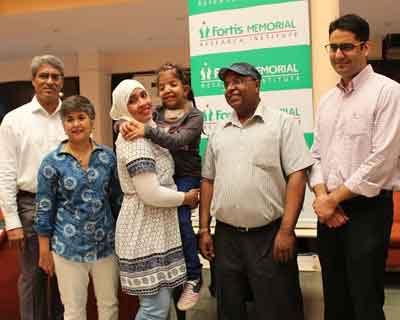- Home
- Editorial
- News
- Practice Guidelines
- Anesthesiology Guidelines
- Cancer Guidelines
- Cardiac Sciences Guidelines
- Critical Care Guidelines
- Dentistry Guidelines
- Dermatology Guidelines
- Diabetes and Endo Guidelines
- Diagnostics Guidelines
- ENT Guidelines
- Featured Practice Guidelines
- Gastroenterology Guidelines
- Geriatrics Guidelines
- Medicine Guidelines
- Nephrology Guidelines
- Neurosciences Guidelines
- Obs and Gynae Guidelines
- Ophthalmology Guidelines
- Orthopaedics Guidelines
- Paediatrics Guidelines
- Psychiatry Guidelines
- Pulmonology Guidelines
- Radiology Guidelines
- Surgery Guidelines
- Urology Guidelines
New Delhi: Six-year-old from Oman born with Crouzon Syndrome given a new life at Fortis

New Delhi : Doctors at Fortis Healthcare achieved another milestone recently when they performed a successful surgery on a six year old international patient, Lyaan from Oman. She had come to Fortis this year with a condition called Crouzon syndrome, a rare genetic disorder found 1 in 60,000 live births (or 16.5 cases in 1 million live births). This condition presents itself in the form of a severely deformed upper face. Though genetic, none of her older or younger siblings suffered from this disorder.
According to her father, Ali Halthy, Lyaan looked normal when she was born, but at age 4-5 months, her upper face started showing deformity, with a retruded upper jaw. She developed breathing distress and had to be tracheostomised at a local hospital back home. She also had to undergo cranial surgery as an infant at the age of one at an Oman hospital, since her head size was not increasing.
Crouzon syndrome has the following symptoms and outcomes:
- Fusion of the cranial sutures also called craniosinostisis (where the head doesn’t grow in size)and this can lead to mental retardation if not operated upon
- Antimongoloid slants – slanting eyelids
- Mid-face hypoplasia – retruded face profile
- Wide, protruding eyes
- A peculiar facial abnormality
- 55% children or patients may report hearing loss
A senior team of specialists from Fortis Healthcare - Dr Rashmi Taneja, Senior Consultant, Plastic & Cosmetic Surgery, Fortis Hospital, Vasant Kunj; Dr Gagan Sabharwal, Maxillofacial Surgeon, Department of Dentistryand Maxillofacial Surgery and Dr Amitabh Singh, Consultant, Cosmetic & Plastic Surgery, Fortis Memorial Research Institute (FMRI)performed the complex surgery in February this year.
Dr Rashmi Taneja, Senior Consultant, Plastic & Cosmetic Surgery, Fortis Hospital, Vasant Kunj shared that “Crouzon syndrome is a rare genetic disorder that may be evident at birth (congenital) or during infancy. It is characterized by distinctive malformations of the skull and facial region. Such abnormalities may vary greatly in range and severity from case to case, including among affected family members. In this case, our team performed the Lefort III Osteotomy, where the mid face was detached from the skull bone with application of rigid external distractors, also called RED Device as part of the treatment on the patient. Lyaan recoveredwell and recently had her distractor removed. A significant point to be noted is that the patient’s family chose to come to Fortis Memorial Research Institute in India to get this rare surgery conducted when they had the choice of opting for a hospital in Europe”.
Dr Gagan Sabharwal, Maxillofacial Surgeon, Department of Dentistry and Maxillofacial Surgery and Dr Amitabh Singh, Consultant, Cosmetic & Plastic Surgery, Fortis Memorial Research Institute stated that,“Aftera consolidation period of four days following the surgery performed at FMRI, the mid face and upper jaw was pulled forward @ 1 mm a day. The distraction was done by her mother who stayed in the hospital’s vicinity. The upper jaw was pulled 35 mm in 35 days after which the family returned to their country for the bones to heal completely. They were asked to come for a follow-up checkup and distractor removal after a couple of months by which time the distracted bone would have healed. The Fortis ENT team has also removed her tracheostomy and Lyaan has started breathing normally through her nose like any other child. She will have to undergo another set of surgery at age 16 to align her jaws.”
As per the National Organisation for Rare Disorders,United States, in most infants with Crouzon syndrome, the fibrous joints between certain bones of the skull (cranial sutures) close prematurely (craniosynostosis). In addition, facial abnormalities typically include unusual bulging or protrusion of the eyeballs (proptosis) due to shallow eye cavities (orbits); outward deviation of one of the eyes (divergent strabismus or exotropia); widely spaced eyes (ocular hypertelorism); and a small, underdeveloped upper jaw (hypoplastic maxilla), with protrusion of the lower jaw (relative mandibular prognathism).
Crouzon syndrome may also be associated with certain neurological abnormalities. For example, one study reported that approximately 30 percent of affected individuals frequently had headaches and about 12 percent experienced episodes of uncontrolled electrical activity in the brain (seizures). In some cases, it may also be associated with certain musculo-skeletal and physical abnormalities. Hearing impairment, abnormalities of the nerves, abnormal deviation of the partition that separates the nostrils and/or unusual smallness of the air-filled cavities that open into the nose, obstruction of the nasal cavities and the upper region of the throat (nasopharyngeal obstruction) may cause respiratory difficulties during infancy. In addition, for some individuals, upper airway obstruction may result in the need to breathe through the mouth.

Disclaimer: This site is primarily intended for healthcare professionals. Any content/information on this website does not replace the advice of medical and/or health professionals and should not be construed as medical/diagnostic advice/endorsement or prescription. Use of this site is subject to our terms of use, privacy policy, advertisement policy. © 2020 Minerva Medical Treatment Pvt Ltd